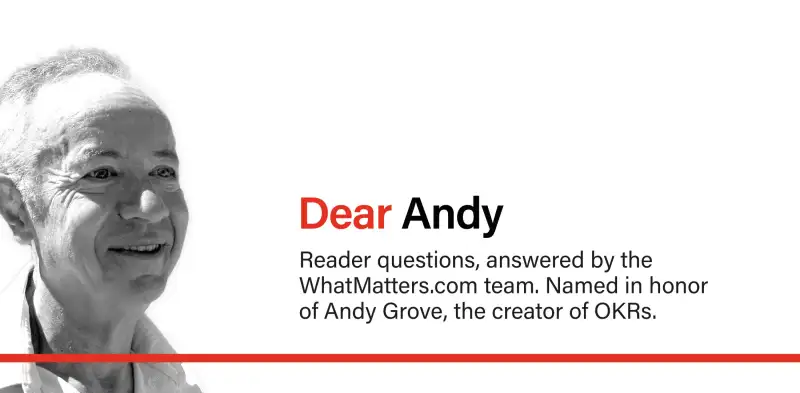Dear Andy,
My question is around cascading top down OKRs. If the Key Result at a higher level becomes an Objective for the next level (either verbatim or variants of the same point), then how are Objectives going to be any different from Key Results?
Sincerely,
Ashish

Hi Ashish!
Thanks for writing in. You’re not alone in your confusion about cascading, so let’s see what we can do to clarify it for you.
When a KR is cascaded, it doesn’t mean it becomes the lower-level team’s Objective word-for-word. Think of cascading as “inspiring” rather than “duplicating.” This means the team must craft at least one OKR to achieve the cascaded KR. That new Objective must align closely with the cascaded KR, but you can rephrase the Objective so that your team’s focus is clear.
Take this example from Upsolve, a nonprofit founded in 2018 that aims to reduce poverty by helping low income Americans file for bankruptcy for free.
Upsolve had a top-level OKR with the Objective of “alleviate $1billion in personal bankruptcy debt.” One of the KRs that would get them to that Objective was “file 1500 cases per month.”
Instead of directly assigning “file 1500 cases per month,” leadership asked each team how they could best contribute to making that goal a reality. That’s cascading. It means, this goal needs to be accounted for in your OKRs. One solution to reaching 1500 cases/month was quadrupling traffic to their website, so that became part of the marketing team’s OKR. Their OKR aimed to operationalize content production and online branding, with KRs around website traffic and increased daily users. Tightly aligned – but not an exact duplicate.
In order to get to the target number of cases, another team from Upsolve determined to increase throughput: completed applications. That team chose an Objective to decrease the time their lawyers spent reviewing each case as the lengthy review time from legal was creating a bottleneck in the amount of applications they were able to process. They also set one of their Key Results to get review time below five minutes per application.
See how that works? No team was strictly cascaded “file 1500 cases per month” to become their new Objective. Instead, they were empowered to use that KR as guidance to create their own OKRs which would enable them to do the most good in making it become reality.
Additionally, don’t forget the concept of laddering here, too. In laddering, instead of inheriting an OKR from above (cascading), a team is inspired by OKRs set anywhere else in the organization. The North Star OKR is usually the most popular source of inspiration. But whether it’s above or across the organization, teams can skip levels to find priorities they believe have the most impact. It is a bottom-up approach to goal setting. In conjunction with cascading, laddering empowers teams to figure out their own means of adding value, rather than having it assigned directly to them.
Thanks for writing in, Ashish, and best of luck to you on your OKR journey.
Sincerely,
Billy from the What Matters Team

